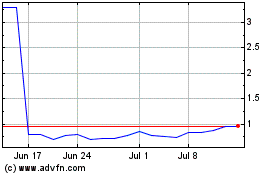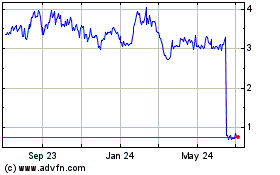Ovid Therapeutics Inc. (NASDAQ:OVID), a biopharmaceutical company
committed to developing medicines that transform the lives of
people with rare neurological diseases, today announced that the
U.S. Food and Drug Administration (FDA) has granted orphan drug
designation to TAK-935/OV935 for the treatment of Dravet syndrome,
a severe and rare form of childhood epilepsy that typically
presents during the first year of life. Takeda Pharmaceutical
Company Limited and Ovid formed a global collaboration to develop
and commercialize TAK-935/OV935 for the treatment of developmental
and epileptic encephalopathies in January 2017.
Dravet syndrome is classified as a developmental and epileptic
encephalopathy, a group of rare epilepsies that cause significant
morbidities and can worsen over time. Children with Dravet syndrome
experience frequent seizures, loss of muscle control, cognitive
deficits and, in approximately 10 percent of cases, death before
the age of 12 years. Moreover, in those who survive into adulthood,
their long-term intellectual development and seizure outcomes are
typically extremely poor.
“We are pleased by the FDA’s decision to grant orphan drug
designation to TAK-935/OV935 for the treatment of Dravet syndrome,
a severe and debilitating disease,” said Dr. Emiliangelo Ratti,
head of Takeda’s Neuroscience Therapeutic Area Unit. “This
designation is a significant step forward in researching a
potential treatment option for people living with Dravet syndrome
for whom therapeutic options are severely limited, and an important
milestone for this investigational molecule.”
TAK-935/OV935 is a potent, highly-selective, first-in-class
inhibitor of the enzyme cholesterol 24-hydroxylase (CH24H). It is
believed that CH24H is involved in over-activation of the
glutamatergic pathway, which has been shown to play a role in the
initiation and spread of seizure activity. To Ovid and Takeda’s
knowledge, TAK-935/OV935 is the only molecule with this mechanism
of action in clinical development.
“We believe that TAK-935/OV935, with its novel mechanism of
action, has the potential to be an innovative treatment for people
with rare epilepsies, such as Dravet syndrome,” said Matthew During
M.D., DSc, FACP, FRACP, president and chief scientific officer of
Ovid Therapeutics. “We have rapidly advanced this program into a
Phase 1b/2a clinical trial and anticipate data in 2018. We look
forward to continuing our work with Takeda to bring this
potentially transformative therapy to patients.”
Orphan drug designation is intended to facilitate and expedite
drug development for rare diseases for which there are no current
treatments available. It also provides substantial benefits to the
sponsor, including the potential for tax credits for clinical
development costs, study-design assistance, and several years of
market exclusivity for the product upon regulatory approval.
About Dravet SyndromeDravet syndrome is a
severe form of childhood epilepsy that typically presents during
the first year of life. It is believed to be largely caused by
mutations in the SCN1A gene. Children experience frequent
seizures, loss of muscle control, cognitive deficits and, in
approximately 10 percent of cases, death before the age of 12
years. While some patients may survive into adulthood, their
long-term intellectual development and seizure outcomes are
typically extremely poor. The incidence of Dravet syndrome in the
United States ranges from 1 in 15,700 to 1 in 20,900 births.
Patients are frequently treated with combinations of classic
anti-epileptic drugs, none of which are particularly effective. No
drugs have been approved specifically for the treatment of Dravet
syndrome in the United States and only one drug, the anticonvulsant
stiripentol, has been approved in Europe.
Dravet syndrome is one of several disorders which together are
designated as developmental and epileptic encephalopathies. This
group includes epilepsy syndromes associated with severe cognitive
and behavioral disturbances. The International League Against
Epilepsy (ILAE) defines an epileptic encephalopathy as a
condition in which “the epileptiform EEG abnormalities themselves
are believed to contribute to a progressive disturbance in cerebral
function.”
These epilepsies cause significant morbidities for patients
beyond what might be expected from the known underlying pathology
alone and can worsen over time. Developmental and epileptic
encephalopathies typically present early in life and are often
associated with severe cognitive and developmental impairment in
addition to frequent treatment-resistant seizures throughout the
person’s lifetime. These disorders vary in age of onset,
developmental outcomes, etiologies, neuropsychological deficits,
electroencephalographic (EEG) patterns, seizure types and
prognosis.
About TAK-935/OV935TAK-935/OV935, which is
being studied in developmental and epileptic encephalopathies, is a
potent, highly-selective, first-in-class inhibitor of the enzyme
cholesterol 24-hydroxylase (CH24H). CH24H is predominantly
expressed in the brain, where it plays a central role in
cholesterol homeostasis. CH24H converts cholesterol to
24S-hydroxycholesterol (24HC), which then exits the brain into the
blood plasma circulation. Glutamate is one of the main
neurotransmitters in the brain and has been shown to play a role in
the initiation and spread of seizure activity. Recent literature
indicates 24HC is involved in over-activation of the glutamatergic
pathway through modulation of the NMDA channel, implying its
potential role in central nervous system diseases such as epilepsy.
To Ovid and Takeda’s knowledge, TAK-935/OV935 is the only molecule
with this mechanism of action in clinical development.
TAK-935/OV935 has been tested in preclinical models to provide
data to support the advancement of the drug into human clinical
studies in patients suffering from rare epilepsy syndromes. A novel
proprietary PET ligand, developed by Takeda and Molecular
Neuroimaging, LLC (MNI), has been used to determine target enzyme
occupancy of TAK-935/OV935 in the brain. In addition, the effect of
TAK-935/OV935 on CH24H enzyme activity in the brain has been
assessed by following measurable reductions in the plasma
concentration of 24HC.
TAK-935/OV935 has completed four Phase 1 clinical studies, which
have assessed tolerability and target engagement at doses believed
to be therapeutically relevant. TAK-935/OV935 is being co-developed
by Ovid and Takeda Pharmaceutical Company Limited.
About Ovid TherapeuticsOvid Therapeutics
(NASDAQ:OVID) is a New York-based biopharmaceutical company using
its BoldMedicine™ approach to develop therapies that transform the
lives of patients with rare neurological disorders. Ovid’s drug
candidate, OV101, is currently in development for the treatment of
Angelman syndrome and Fragile X syndrome. Ovid initiated the Phase
2 STARS trial of OV101 in people with Angelman syndrome in 2017 and
completed a Phase 1 trial in adolescents with Angelman syndrome or
Fragile X syndrome. Ovid is also developing OV935 in collaboration
with Takeda Pharmaceutical Company Limited for the treatment of
epileptic encephalopathies and in August 2017 initiated a Phase
1b/2a trial of OV935.
For more information on Ovid, please visit
http://www.ovidrx.com/.
Forward-Looking StatementsThis press release
includes certain disclosures that contain
“forward-looking statements,” including, without limitation,
statements regarding the progress, timing, scope and results of
clinical trials for Ovid’s product candidates, the reporting of
clinical data regarding Ovid’s product candidates, and the
potential use of TAK-935/OV935 to treat rare epilepsies. You
can identify forward-looking statements because they contain words
such as “will,” “believes” and “expects.” Forward-looking
statements are based on Ovid’s current expectations and
assumptions. Because forward-looking statements relate to the
future, they are subject to inherent uncertainties, risks and
changes in circumstances that may differ materially from those
contemplated by the forward-looking statements, which are neither
statements of historical fact nor guarantees or assurances of
future performance. Important factors that could cause actual
results to differ materially from those in the forward-looking
statements are set forth in Ovid’s filings with the Securities and
Exchange Commission, including its Quarterly Report on Form
10-Q for the quarter ended September 30, 2017, under the
caption “Risk Factors.” Ovid assumes no obligation to update
any forward-looking statements contained herein to reflect any
change in expectations, even as new information becomes
available.
ContactsInvestors: Burns McClellan Steve Klass,
212-213-0006 Sklass@burnsmc.com
Media: Pure Communications, Inc. Katie Engleman, 910-509-3977
katie@purecommunicationsinc.com
Ovid Therapeutics (NASDAQ:OVID)
Historical Stock Chart
From Mar 2024 to Apr 2024

Ovid Therapeutics (NASDAQ:OVID)
Historical Stock Chart
From Apr 2023 to Apr 2024
